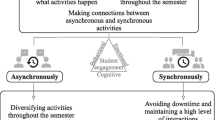Abstract
Large classroom configurations and lecture-centered pedagogy discourage student engagement. The advances in educational technology have empowered instructors to fill the gap. This study designed a digital question board (DQB) on digital canvas to facilitate student engagement in large lecture classes. A mixed-methods study with a quasi-experiment was conducted to investigate the influence of such intervention. The study was situated in an introductory research methodology course in a large comprehensive university in eastern China (n = 253). The quasi-experiment lasted for six weeks. The data from surveys, interviews, observations, and online posts were collected and analyzed. This study mainly presented qualitative analysis results from the exploratory approach. Eight themes emerged from 12 interviews, 161 survey responses and 457 student posts were discussed. It was found that following the proposed design principles, the presence of a DQB effectively facilitated students’ cognitive and emotional engagement. The enhanced self-regulation and co-construction of knowledge all led to the improved cognitive engagement. The reduced social pressure of questioning and increased interactivity contributed most to their emotional engagement.

Similar content being viewed by others
References
Baron, D., Bestbier, A., Case, J. M., & Collier-Reed, B. I. (2016). Investigating the Effects of a Backchannel on University Classroom Interactions: A Mixed-Method Case Study. Computers and Education, 94(C), 61–76. https://doi.org/10.1016/j.compedu.2015.11.007
Carpenter, J. P. (2015). Digital backchannels: giving every student a voice. (Special topic). Educational leadership, 72(8), 54–58
Creswell, J. W. (2015). Educational research: Planning, conducting, and evaluating quantitative and qualitative research (4th ed.). Pearson India
Er, E., Kopcha, T. J., & Orey, M. (2015). Exploring college students’ online help-seeking behavior in a flipped classroom with a web-based help-seeking tool. Australasian Journal of Educational Technology, 31(5), 537–555
Fassinger, P. (1995). Understanding Classroom Interaction: Students’ and Professors’ Contributions to Students’ Silence. The Journal of Higher Education, 66(1), 82–96
Flaherty, C. (2020). Much Ado About Class Size. Retrieved from https://www.insidehighered.com/news/2020/06/18/study-some-things-matter-more-class-size-when-it-comes-student-success. Accessed August 8, 2021
Flammer, A. (1981). Towards a theory of question-asking; and predicting what questions people ask. Psychological Research Psychologische Forschung, 43, 407–420. (e-copy request from SU)
Fletcher, A. K. (2018). Help-seeking: agentic learners initiating feedback. Educational Review, 70(4), 389–408
Fredricks, J. A., Blumenfeld, P., & Paris, A. (2004). School Engagement: Potential of the Concept, State of the Evidence. Review of Educational Research, 74(1), 59–109
Fredricks, J. A., Reschly, A., & Christenson, S. (2019). Handbook of Student Engagement Interventions: Working with Disengaged Students. Academic Press
Han, J. H. (2014). Closing the Missing Links and Opening the Relationships among the Factors: A Literature Review on the Use of Clicker Technology Using the 3P Model. Educational Technology & Society, 17(4), 150–168
Harunasari, S. Y., & Halim, N. (2019). Digital backchannel: Promoting students’ engagement in EFL large class. International Journal of Emerging Technologies in Learning, 14(7), 163–178
Henrie, C. R., Halverson, L. R., & Graham, C. R. (2015). Measuring student engagement in technology-mediated learning: A review. Computers & Education, 90, 36–53
Huang, K., & Law, V. (2018). Learners’ engagement online in peer help. American Journal of Distance Education, 32(3), 177–189
Hunsu, N. J., Adesope, O., & Bayly, D. J. (2016). A meta-analysis of the effects of audience response systems (clicker-based technologies) on cognition and affect. Computer & Education, 94, 102–119
Jackson, H., Nayyar, A., Denny, P., Luxton-Reilly, A., & Tempero, E. (2018). HandsUp: An In-Class Question Posing Tool. IEEE International Conference on Learning and Teaching in Computing and Engineering (LaTICE) - Auckland, New Zealand, 2018, 24–31
Junco, R., Heiberger, G., & Loken, E. (2011). The effect of Twitter on college student engagement and grades. Journal of Computer Assisted Learning, 27, 119–132
Kay, R. H., & Knaack, L. (2009). Assessing learning, quality, and engagement in learning objects: The Learning Object Evaluation Scale for Students (LOES-S). Education Technology Research and Development, 57, 147–168
Koszalka, T., & Ntloedibe-Kuswani, G. S. (2010). The literature on the safe and disruptive learning potential of mobile-technologies. Distance Education, 31(2), 139–150
Morse, J. M. (2010). Procedures and practice of mixed method design: Maintaining control, rigor, and complexity. Sage Handbook of Mixed Methods in Social & Behavioral Research (2nd ed.)., pp. 339–353). Thousand Oaks: Sage
Patton, M. Q. (1990). Qualitative Evaluation and Research Methods (2nd ed.).). Newbury Park, CA: Sage Publications, Inc.
Puustinen, M., Bernicot, J., Volckaert-Legrier, O., & Baker, M. (2015). Naturally occurring help-seeking exchanges on a homework help forum. Computers & Education, 81, 89–101
Rodriguez-Triana, M. J., Prieto, L. P., Holzer, A., & Gillet, D. (2020). Instruction, Student Engagement and Learning Outcomes: A Case Study Using Anonymous Social Media in a Face-to-face Classroom. IEEE Transactions on Learning Technologies, 2020, 1–1
Sawang, S., O’Connor, P., & Ali, M. (2017). IEngage: Using technology to enhance students’ engagement in a large classroom. Journal of Learning Design, 10(1), 11
Vygotsky, L. S. (1978). In V. M.Cole, S. JohnSteiner, Scribner, & E. Souberman (Eds.), Mind in society: The development of higher psychological processes. Cambridge, MA: Harvard University Press
Webb, N. M. (1982). Student interaction and learning in small groups. Review of Educational Research, 52(3), 421–445
Welch, B. K., & Bonnan-White, J. (2012). Twittering to increase student engagement in the university classroom. Knowledge Management & E-Learning, 4(3), 325–345
Yates, K., Birks, M., Woods, C., & Hitchins, M. (2015). #Learning: the use of backchannel technology in multi-campus nursing education. Nurse Education Today, 35(9), 65–69
Zhang, L., Cheng, J., Lei, J., Wang, Q., & Yang, F. (2021). Using digital canvas to facilitate student questioning in large lecture classes: a mixed-methods study. Interactive Learning Environments. https://doi.org/10.1080/10494820.2021.2007135
Author information
Authors and Affiliations
Corresponding author
Additional information
Publisher’s Note
Springer Nature remains neutral with regard to jurisdictional claims in published maps and institutional affiliations.
Rights and permissions
About this article
Cite this article
Zhang, L., Cheng, J., Lei, J. et al. Facilitating student engagement in large lecture classes through a digital question board. Educ Inf Technol 28, 2091–2106 (2023). https://doi.org/10.1007/s10639-022-11197-z
Received:
Accepted:
Published:
Issue Date:
DOI: https://doi.org/10.1007/s10639-022-11197-z




